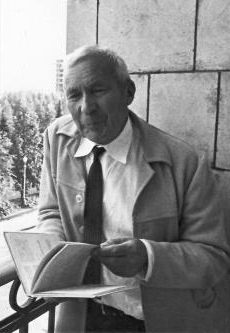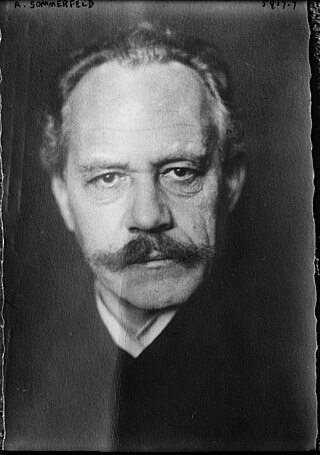The Annals of Mathematics is a mathematical journal published every two months by Princeton University and the Institute for Advanced Study.

Vladimir Igorevich Arnold was a Soviet and Russian mathematician. He is best known for the Kolmogorov–Arnold–Moser theorem regarding the stability of integrable systems, and contributed to several areas, including geometrical theory of dynamical systems, algebra, catastrophe theory, topology, real algebraic geometry, symplectic geometry, differential equations, classical mechanics, differential-geometric approach to hydrodynamics, geometric analysis and singularity theory, including posing the ADE classification problem.

Andrey Nikolaevich Kolmogorov was a Soviet mathematician who played a central role in the creation of modern probability theory. He also contributed to the mathematics of topology, intuitionistic logic, turbulence, classical mechanics, algorithmic information theory and computational complexity.

Arnold Johannes Wilhelm Sommerfeld, was a German theoretical physicist who pioneered developments in atomic and quantum physics, and also educated and mentored many students for the new era of theoretical physics. He served as doctoral supervisor and postdoc supervisor to seven Nobel Prize winners and supervised at least 30 other famous physicists and chemists. Only J. J. Thomson's record of mentorship offers a comparable list of high-achieving students.
Philip McCord Morse, was an American physicist, administrator and pioneer of operations research (OR) in World War II. He is considered to be the father of operations research in the U.S.

Isis is a quarterly peer-reviewed academic journal published by the University of Chicago Press for the History of Science Society. It covers the history of science, history of medicine, and the history of technology, as well as their cultural influences. It contains original research articles and extensive book reviews and review essays. Furthermore, sections devoted to one particular topic are published in each issue in open access. These sections consist of the Focus section, the Viewpoint section and the Second Look section.

Topology was a peer-reviewed mathematical journal covering topology and geometry. It was established in 1962 and was published by Elsevier. The last issue of Topology appeared in 2009.

The American Journal of Mathematics is a bimonthly mathematics journal published by the Johns Hopkins University Press.

William Vermillion Houston was an American physicist who made contributions to spectroscopy, quantum mechanics, and solid-state physics as well as being a teacher and administrator. He became the second president of Rice University in 1946.

Peter Henry George Aczel was a British mathematician, logician and Emeritus joint Professor in the Department of Computer Science and the School of Mathematics at the University of Manchester. He is known for his work in non-well-founded set theory, constructive set theory, and Frege structures.

Victor Vladimirovich Goryunov is a Russian mathematician born in 1956. He is a leading figure in Singularity theory, whose contributions to the subject are fundamental. He has published several books and a variety of papers in singularity theory, finite type invariants, and Legendrian knots. Many of his papers in Lagrangian and Legendrian geometry are now considered to be classical in the subject.

Mladen Bestvina is a Croatian-American mathematician working in the area of geometric group theory. He is a Distinguished Professor in the Department of Mathematics at the University of Utah.

Ronald Brown FLSW is an English mathematician. Emeritus Professor in the School of Computer Science at Bangor University, he has authored many books and more than 160 journal articles.

Joseph S. B. Mitchell is an American computer scientist and mathematician. He is Distinguished Professor and Department Chair of Applied Mathematics and Statistics and Research Professor of Computer Science at Stony Brook University.

Compositio Mathematica is a monthly peer-reviewed mathematics journal established by L.E.J. Brouwer in 1935. It is owned by the Foundation Compositio Mathematica, and since 2004 it has been published on behalf of the Foundation by the London Mathematical Society in partnership with Cambridge University Press. According to the Journal Citation Reports, the journal has a 2020 2-year impact factor of 1.456 and a 2020 5-year impact factor of 1.696.
Peter John Diggle, is a British statistician. He holds concurrent appointments with the Faculty of Health and Medicine at Lancaster University, and the Institute of Infection and Global Health at the University of Liverpool. From 2004 to 2008 he was an EPSRC Senior Research Fellow. He is one of the founding co-editors of the journal Biostatistics.

Sergei Tabachnikov, also spelled Serge, is an American mathematician who works in geometry and dynamical systems. He is currently a Professor of Mathematics at Pennsylvania State University.

Sabir Medgidovich Gusein-Zade is a Russian mathematician and a specialist in singularity theory and its applications.

Greta Cvetanova Panova is a Bulgarian-American mathematician. She is a professor of mathematics and Gabilan Distinguished Professor in Science and Engineering at the University of Southern California in Los Angeles. Her research interests include combinatorics, probability and theoretical computer science.














